Jaisalmer Itinerary For 3 Days
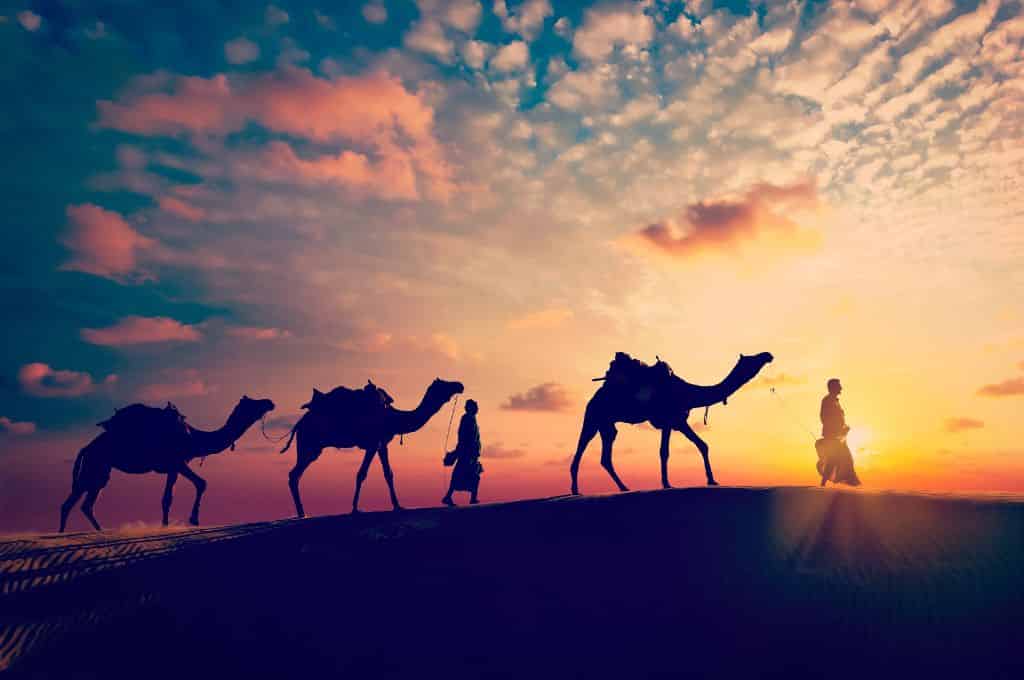
- By Seema
- Updated on January 29, 2025
Jaisalmer is a princely state in the Indian state of Rajasthan. Known as the “Golden City,” it’s defined by its yellow sandstone architecture that has been preserved for centuries. Thanks to its abundant golden dunes and a town built with golden honey sandstones, Jaisalmer is truly “golden” everywhere. This charming city, once considered an offbeat travel destination, has steadily gained popularity among travelers, partly due to Instagram and improved connectivity.
Rawal Jaisal founded Jaisalmer in the twelfth century. The historic area is still steeped in the past, and every corner of the city offers stunning architecture, a thriving culture, and centuries-old traditions. With its narrow streets packed with jostling crowds, quaint shops, and vibrant offerings, the city exudes an old-world charm.
The Jaisalmer Fort, perched atop a three-peaked hill, looms over the town and is unquestionably the highlight of any visit to Jaisalmer. The magnificent dunes of the Thar Desert are also easily accessible from Jaisalmer. From exploring the impressive Jain temples and Havelis to sleeping under the stars and learning about its intriguing past, Jaisalmer has plenty to keep you entertained. Within three days, you can easily visit the majority of the well-known sites in this small and compact city.
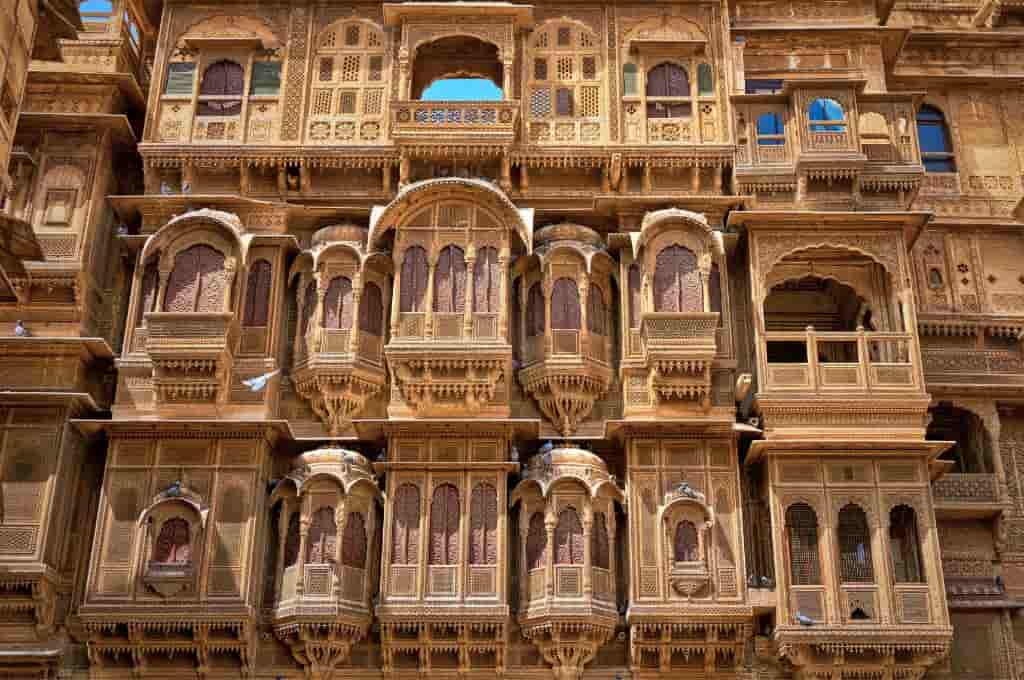
Jaisalmer Itinerary: Day 1
The itinerary for your first day will depend on your arrival time in Jaisalmer. Hopefully, you arrive by noon so that you have enough time to visit a couple of the popular Havelis, browse some local shops, and watch the sunset at Gadisar Lake. You can cap off the day by dining on a rooftop with spectacular views of the Jaisalmer Fort. Or take a foodie tour of the old city before retiring for the night.
1) Patwon ki Haveli, Jaisalmer
This is our first stop of the 3-day Jaisalmer Itinerary. Patwon ki Haveli is one of the three major havelis in Jaisalmer and is not to be missed. It is a grand cluster of 5 small Havelis that were built between 1800 and 1860 by Guman Chand Patwa, one for each of his sons. The Havelis have wooden ceilings, airy courtyards, beautiful arches, and 60 balconies carved with exquisite mirrorwork, murals, and paintings. Every Haveli has a unique style that sets it apart from the others. The interiors are as regal as the exteriors, and you will be impressed by the grandeur and architecture on display. A museum featuring rare artifacts, paintings, and furniture has been established in one of the Havelis.
Timing: 9 am to 5 pm
Time Required: 1 hour
Entry Tickets: Indians: Rs 20, Foreign Tourists: Rs 100;

2) Nathmal ki Haveli, Jaisalmer
Our next stop is a short walk from Patwon ki Haveli. Maharaja Beri Sai commissioned Nathmal ki Haveli to serve as the residence of Prime Minister Diwan Mohata Nathmal, hence the name. The Haveli was built in 1885 by two Muslim brothers, and the architecture is an excellent blend of Islamic and Rajput architecture. Although not exact replicas, the two buildings share many similarities. The gorgeous paintings on the first floor, which were created with 1.5 kg of gold leaf, are the main attraction. You can gain a glimpse of life in a bygone era by examining the walls, which are adorned with images of horses, cattle, and flora.
Timing: 8 am to 7 pm
Time Required: 30 minutes
Entry Tickets: No Fees
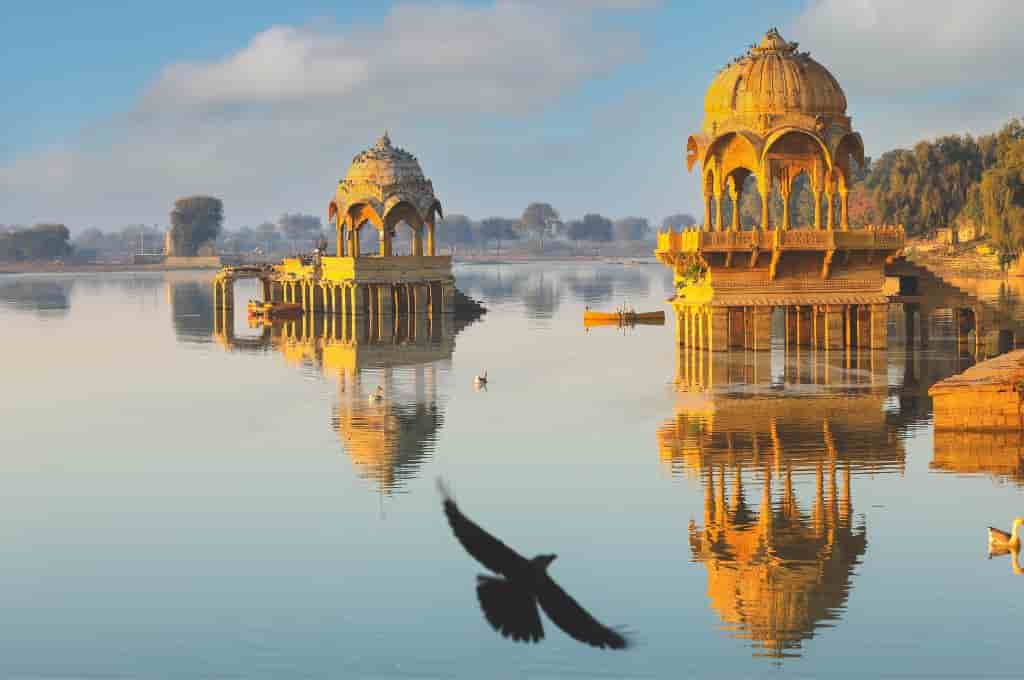
3) Gadisar Lake, Jaisalmer
We’d like to visit Gadisar Lake, located on the outskirts of Jaisalmer. The tranquil spot is one of Jaisalmer’s top attractions for spending an idyllic evening away from the crowded city and enjoying a spectacular sunset. Raja Rawal Jaiswal constructed Lake Gadisar in 1156 AD as a conservation reservoir; water from this man-made oasis was used to supply the entire arid area. Shallow ghats, Hindu shrines, and elegant cenotaphs surround the artificial lake. You can go boating, explore the sacred temples, and enjoy picturesque vistas of the lake and the nearby fort. Due to its proximity to the Bharatpur Bird Sanctuary, Gadisar Lake attracts a wide range of migratory and exotic bird species, making it a haven for bird enthusiasts during the winter months.
Timing: 8 am-7 pm
Time Required: 1-2 hours
Entry Tickets: Free
Jaisalmer Itinerary: Day 2
Spend the first part of your second day exploring the Jaisalmer Fort. You can hire a guide to help you through the fort’s narrow lanes to get the most out of your limited time. Leave for Sam Sand Dunes by 4 p.m. to ensure you’re in time to witness the gorgeous sunset. You can spend the night at the camp or return to Jaisalmer after the evening activities.
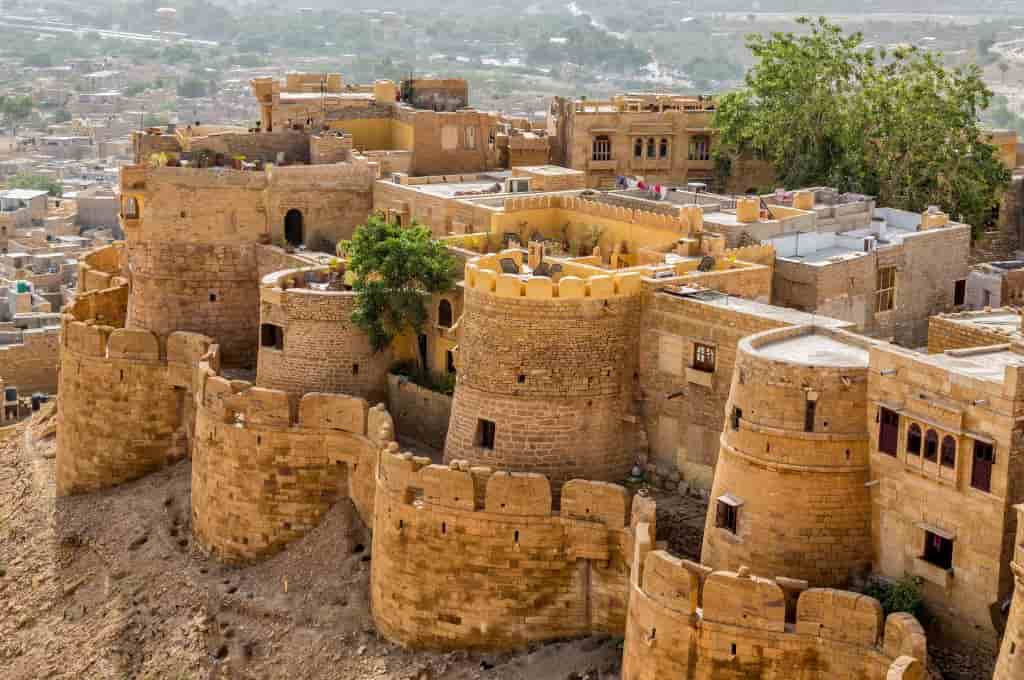
1) Jaisalmer Fort, Jaisalmer
Jaisalmer Fort, which is situated right in the heart of the city, is a must-see attraction for any traveler to Jaisalmer. The UNESCO World Heritage Site was built in 1156 AD by Rawal Jaiswal, the ruler of the Bhati tribe. Perched atop Tirkuta Hill, the fort epitomizes Rajasthani architecture with its yellow crenelated sandstone construction. Encircling its formidable facades are four magnificent gates and 99 bastions. The Jaisalmer Fort, also known as Sonar Qila, has survived numerous attacks from various kings over the years. Reaching a height of 250 feet, the imposing fort provides sweeping views of Jaisalmer city from its epic viewpoints.
The Qila is often referred to as the “Living Fort” because it is home to nearly 3,000 people. Over one-fourth of the city’s population lives in the fort, which is a jumble of centuries-old houses, shops, palaces, temples, museums, restaurants, and cafes. Walking through the labyrinthine lanes, visiting the stunning Jain temples, dining at rooftop eateries, listening to folk music, and haggling for local handicrafts are among the most culturally immersive experiences within the fort. There are seven 12th-century Jain temples located in Jaisalmer Fort. Fascinating sculptures of humans and animals adorn the walls and domes of these incredible temples. Housed in the temples are 6666 statues representing the 24 Tirthankaras of Jainism. The seven Jain temples are interconnected and constitute a significant pilgrimage site for Jains.
Timing: Any Time
Time Required: 3-4 hours
Entry Tickets: Free
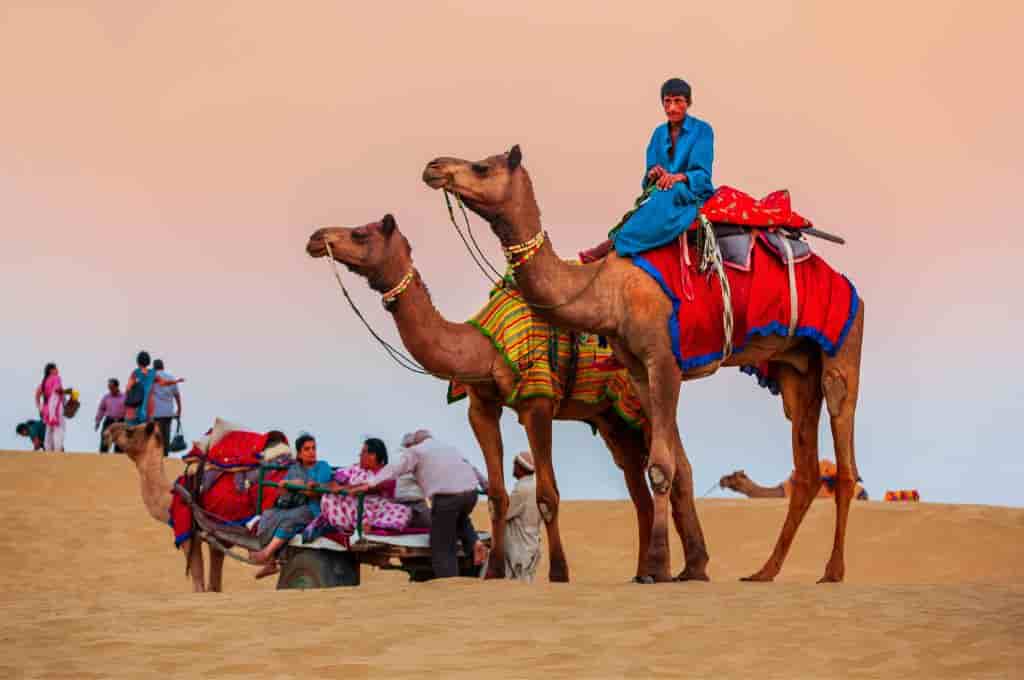
2) Sam Sand Dunes, Jaisalmer
Later in the day, make your way to Sam Sand Dunes in the That Desert. The dunes, 42 kilometers from the city, are the best place to experience an authentic Desert safari. Sam Sand Dunes stretch for miles and miles into the horizon, and it’s easy to get lost if you’re not vigilant. To explore the sand dunes, you can take a jeep or ride a camel. Sunsets are truly magical here, as the crimson horizon reflects brilliantly on the golden sand.
Stay overnight at one of the numerous camping sites in the area to experience the complete desert. There are a variety of accommodations available, ranging from luxury tents to budget options, that will provide you with the perfect space and opportunity to immerse yourself thoroughly in the rugged beauty of your surroundings. Sleep under a blanket of stars, savor Rajasthani delicacies over a bonfire, and enjoy cultural evenings with traditional folk music and Kalbeliya dance. Khuri Sand Dunes is another option if you’re looking for dunes that are less commercialized than the Sam Sand Dunes. They are also roughly 40 kilometers from the city and offer comparable adventures without crowds.
Timing: Open all days
Time Required: Depends on the activities
Entry Tickets: No Entry Fees.
Camel Ride: Rs 50-Rs 200, Jeep Safari: Rs 500-Rs 1500
Jaisalmer Itinerary: Day 3
The day plan will depend on where you were the night before. If you stayed overnight at Sam Sand Dunes, depart for Jaisalmer early in the morning and make a stop at Kuldhara Village (40 km). After a few hours of trying to solve the mystery of the Ghost Village, you should leave. If you’re staying in Jaisalmer, consider taking a round-trip to Kuldhara village, located 18 kilometers away. Either way, you’ll return to Jaisalmer by midday. For the next few hours, you are free to do as you please: rest, shop, or sample some of the local cuisines. In the late afternoon, head to Bada Bagh and Vyas Chatri to witness another amazing sunset. You’ve finished for the day. It’s now time to depart for your next destination, whether by night train, the following morning by plane, or by car.

1) Kuldhara Village, Jaisalmer
Known as the ‘Ghost Village’ of Jaisalmer, Kuldhara Village is located 18 km from the city center. In the nineteenth century, the Kuldhara village and its 83 nearby villages were abandoned overnight. It’s still a mystery why the entire region was abandoned. Folklore has it that Salim Singh, a state minister, desired to wed the chief’s daughter. Instead of complying with the minister’s request, the villagers fled into the night to avoid horrific consequences. The villagers’ curse is believed to be the reason for the absence of human habitation for centuries. Honestly, the village offers little more than the crumbling remains of a few temples, stepwells, and other structures. Tourists are drawn to the mystery surrounding Kuldhara Village and come to see it for themselves.
Timing: Open all days, 8 am to 6 pm (recommended)
Time Required: 2-3 hours
Entry Tickets: Rs 10, For Car: Rs 50

2) Bada Bagh, Jaisalmer
Six kilometers outside of Jaisalmer, Bada Bagh is home to an enormous collection of cenotaphs, or chhatris, erected in honor of the late Maharajas of Jaisalmer. Jait Singh commissioned the Bada Bagh in the 16th century AD, but it was completed by his son Raja Lunakaran after his demise. Additional Chhatris were added to the Bada Bagh between the 16th and 20th centuries, when it served as a royal family crematorium. Royal domes of various shapes and sizes are scattered throughout the park. You’ll be amazed by the fantastic fusion of Mughal, Rajput, and Paliwal architectural styles. The dramatic setting of the honeycombed cenotaphs makes Bada Bagh a popular destination for pre-wedding shoots and Instagram shots.
Timing: Open all days, 8 am to 6 pm
Time Required: 1 hour
Entry Tickets: Rs 100
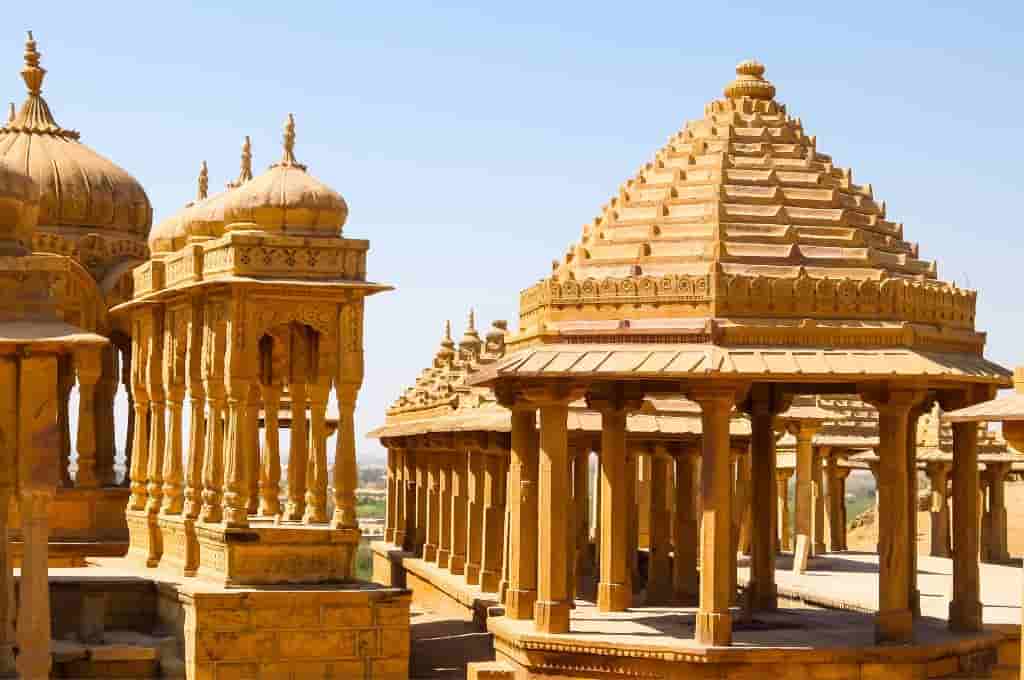
3). Vyas Chhatri, Jaisalmer
Vyas Chhatri is situated 4 km from the city centre and 7 km from Bada Bagh. It also has an impressive collection of meticulously carved sandstone cenotaphs. Constructed atop a former Brahmin cemetery, it honors Sage Ved Vyasa, the penman of the Mahabharata. Vyas Chhatri, situated atop a hill, is renowned as the city’s sunset point due to its panoramic view of the sun setting over the Sonar Fort and the city of Jaisalmer.
Timing: Open all days, 8 am to 7:30 pm
Time Required: 1 hour
Entry Tickets: Rs 100
Best Time to Visit Jaisalmer?
The best time to visit Jaisalmer is from October to March, when the weather is pleasant and the average temperature ranges between 10 and 30 degrees. December and January are the busiest travel months in Jaisalmer, so expect higher hotel and airfare rates. The Desert Festival takes place in February and March. If you can plan your trip during this time, you will have the opportunity to experience Rajasthani culture through folk dances, camel races, puppet shows, and other cultural events that are typically organized during this period. It’s best to avoid April through July because of the intense heat. As there is little rainfall in the region, you can plan a vacation in August or September, but there will be fewer activities and camping options available.

How to Reach Jaisalmer?
Jaisalmer is located in the far west of Rajasthan and is somewhat difficult to reach. However, if you combine a trip to Jaisalmer with other destinations in Rajasthan, such as Jodhpur, Jaipur, or Udaipur, everything will fall into place.
- By Air: Jaisalmer Airport is only operational during the winter months and serves a few cities such as Delhi, Jaipur, Ahmedabad, and Mumbai. The other airport in the vicinity is Jodhpur Airport, located approximately 285 kilometers from Jaisalmer. The nearest international airport is Indira Gandhi International Airport, also commonly referred to as Delhi Airport. Jaisalmer Airport is about 15 kilometers from the city.
- By train: Jaisalmer is well connected by train to many cities, and there are numerous options for visitors traveling from anywhere in India. There are direct trains to Jaisalmer from cities such as Jodhpur, Jaipur, Delhi, Mumbai, and even Kolkata, among many others. For those who want to travel within Rajasthan, three trains run daily between Jodhpur and Jaisalmer. Every Sunday, the Palace on Wheels, a luxury train, makes a stop in Jaisalmer. You can take a private taxi or an autorickshaw into the town from the Jaisalmer Railway Station.
- By Road: Jaisalmer is linked by road to the major cities of Rajasthan and Gujarat. The highways are in good condition and well-maintained. You could drive to Jaisalmer from the nearby towns or take a taxi/private car. The drive from Jodhpur to Jaisalmer takes 5-6 hours. The Rajasthan State Road Transport Corporation runs buses to and from Jaisalmer on a daily schedule. All major cities in Rajasthan, Gujarat, and some other parts of India have bus services to Jaisalmer.
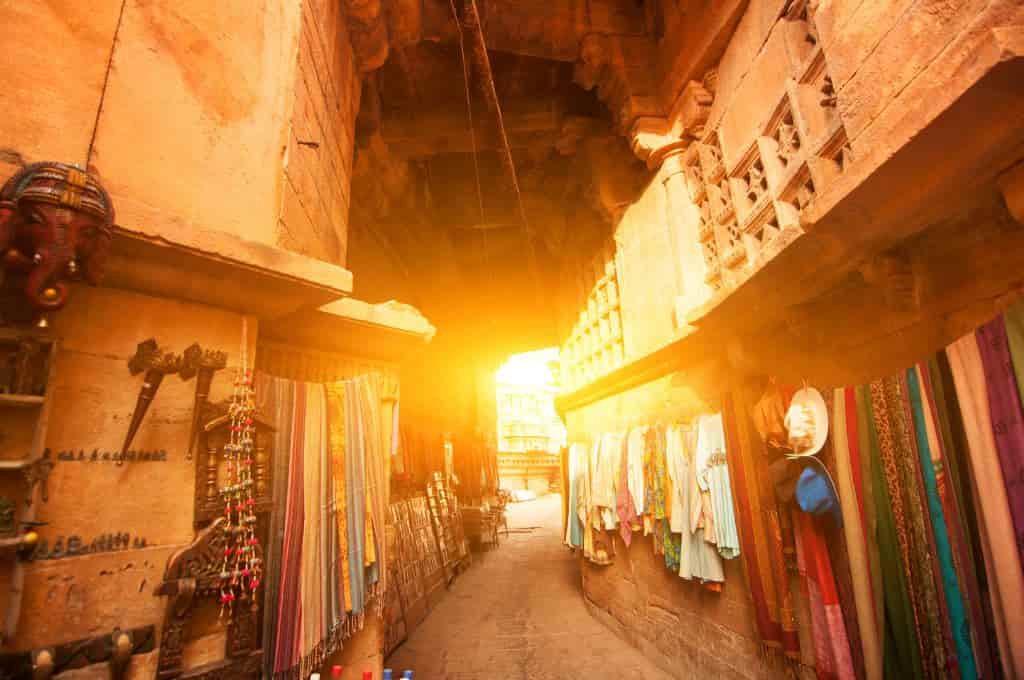
How to Get Around in Jaisalmer?
Given the small size of Jaisalmer, getting around is not a problem. The Jaisalmer Fort, Havelis, local shops, and other attractions are all conveniently located near one another, making it easy to explore them on foot. This is your chance to learn about the local culture and discover hidden street shops. If you want to go outside the city, you can readily catch an auto-rickshaw or hire a two-wheeler. If you are uncomfortable riding a two-wheeler, consider booking a four-wheeler to travel to Kuldhara Village and the Sand Dunes: reserve tours, private vehicles, and taxis through reliable sources. There are no Ola or Uber options in Jaisalmer.
Where to Stay in Jaisalmer?
Hostels, low-cost hotels, campsites, and expansive resorts have proliferated throughout Jaisalmer, offering a range of lodging options to suit every taste and budget. The palatial bespoke hotel, Suryagarh, stands out among the usual run-of-the-mill offerings. If you can afford it, you should definitely consider staying there. For those seeking luxury, Jaisalmer Marriott is an excellent alternative. If these accommodations are too expensive for you, consider Nachanaa Haveli and Sonaar Haveli. For those on a tight budget, Zostel is a reliable and secure choice. Staying within the fort walls is an option, with about thirty hotels located within the Jaisalmer Fort.
Shopping in Jaisalmer?
A trip to Jaisalmer would be incomplete without exploring the maze-like markets and shopping for the colorful wares on display. The city is renowned for its silk fabrics (Bhatia Bazaar), leather goods (Manak Chowk), textiles (Seema Gramme), silver jewelry (Sonarron ka Baas), paintings and carpets (Sadar Bazaar), and silk fabrics (Pansari Bazaar). Therefore, don’t miss the opportunity to indulge in a shopping spree and purchase locally made handicrafts and textiles.
Where to Eat in Jaisalmer?
Rajasthanis are foodies, and you will find delicious food wherever you go. Jaisalmer also has some excellent restaurants serving authentic Rajasthani cuisine as well as delicacies from other regions. Try local Rajasthani dishes, such as Gatte Ki Sabzi, Ker Sangri, Dal Baati Churma, and Laal Maas. You can check out these restaurants:
The Trio, Suryagarh Restaurant, Jaisal Italy, Kuku Cafe, Fotiya’s Restaurant, Milan, Free Tibet, Desert Boy’s Dhani, Saffron, Gaji’s Restaurant, Green Park, Pleasant Haveli, Golden Roof, The Traveler’s Cup
